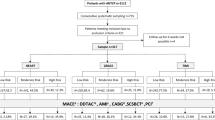Abstract
The history, electrocardiogram, age, risk factors, troponin (HEART) and global registry of acute coronary events (GRACE) scoring systems are commonly used to risk stratify patients with chest pain. This study investigated the application of these scores in predicting the short-term risk of a major adverse cardiac event (MACE) in patients with chest. A total of 509 patients were analyzed. All patients were followed up for 30 days after visiting our emergency department. At 30 days post-admission, the primary outcome (MACE) was recorded in 92 patients (18.1%), 88 (95.6%) of whom had experienced an acute myocardial infarction. Thirty-seven (40.2%) of the patients with a MACE underwent percutaneous coronary intervention and six patients (6.5%) died. The HEART and GRACE scores were both significantly higher in patients who developed a MACE than in those without (P < 0.05). The HEART and GRACE scores had c-statistic values of 0.811 (95% CI 0.774–0.844) and 0.648 (95% CI 0.603–0.688), respectively. The Hosmer–Lemeshow statistic revealed that the HEART and GRACE scores had values of 8.68 (P = 0.39) and 10.45 (P = 0.11), respectively. The percentages of patients with HEART scores of 0–3, 4–6, and 7–10 were 3.0%, 26.2%, and 46.3%, respectively, in those with a MACE within 30 days. The findings show that while both scoring systems are useful, the HEART score is superior to the GRACE score for predicting the occurrence of MACE within 30 days in patients with chest pain.


Similar content being viewed by others
References
Lee TH, Goldman L (2000) Evaluation of the patient with acute chest pain. N Engl J Med 342(16):1187–1195. https://doi.org/10.1056/NEJM200004203421607
Rahko PS (2014) Rapid evaluation of chest pain in the emergency department. JAMA Intern Med 174(1):59–60. https://doi.org/10.1001/jamainternmed.2013.9978
Holly J, Fuller M, Hamilton D et al (2013) Prospective evaluation of the use of the thrombolysis in myocardial infarction score as a risk stratification tool for chest pain patients admitted to an ED observation unit. Am J Emerg Med 31(1):185–189. https://doi.org/10.1016/j.ajem.2012.07.006
Ang DS, Wei L, Kao MP, Lang CC, Struthers AD (2009) A comparison between B-type natriuretic peptide, global registry of acute coronary events (GRACE) score and their combination in ACS risk stratification. Heart 95(22):1836–1842. https://doi.org/10.1136/hrt.2008.160234
Mahler SA, Riley RF, Hiestand BC et al (2015) The HEART pathway randomized trial: identifying emergency department patients with acute chest pain for early discharge. Circ Cardiovasc Qual Outcomes 8(2):195–203. https://doi.org/10.1161/CIRCOUTCOMES.114.001384
Khan E, Brieger D, Amerena J et al (2018) Differences in management and outcomes for men and women with ST-elevation myocardial infarction. Med J Aust 209(3):118–123
Six AJ, Backus BE, Kelder JC (2008) Chest pain in the emergency room: value of the HEART score. Neth Heart J 16(6):191–196. https://doi.org/10.1007/bf03086144
Backus BE, Six AJ, Kelder JC et al (2010) Chest pain in the emergency room: a multicenter validation of the HEART Score. Crit Pathw Cardiol 9(3):164–169. https://doi.org/10.1097/HPC.0b013e3181ec36d8
Cullen L, Greenslade J, Hammett CJ et al (2013) Comparison of three risk stratification rules for predicting patients with acute coronary syndrome presenting to an Australian emergency department. Heart Lung Circ 22(10):844–851. https://doi.org/10.1016/j.hlc.2013.03.074
Graham CA, Chan JW, Chan CP, Cattermole GN, Rainer TH (2014) Prospective validation of thrombolysis in myocardial infarction and front door thrombolysis in myocardial infarction risk scores in Chinese patients presenting to the ED with chest pain. Am J Emerg Med 32(11):1339–1344. https://doi.org/10.1016/j.ajem.2014.08.032
Six AJ, Cullen L, Backus BE et al (2013) The HEART score for the assessment of patients with chest pain in the emergency department: a multinational validation study. Crit Pathw Cardiol 12(3):121–126. https://doi.org/10.1097/HPC.0b013e31828b327e
Backus BE, Six AJ, Kelder JC et al (2013) A prospective validation of the HEART score for chest pain patients at the emergency department. Int J Cardiol 168(3):2153–2158. https://doi.org/10.1016/j.ijcard.2013.01.255
Mahler SA, Hiestand BC, Goff DC Jr, Hoekstra JW, Miller CD (2011) Can the HEART score safely reduce stress testing and cardiac imaging in patients at low risk for major adverse cardiac events? Crit Pathw Cardiol 10(3):128–133. https://doi.org/10.1097/HPC.0b013e3182315a85
Sakamoto JT, Liu N, Koh ZX et al (2016) Comparing HEART, TIMI, and GRACE scores for prediction of 30-day major adverse cardiac events in high acuity chest pain patients in the emergency department. Int J Cardiol 221:759–764. https://doi.org/10.1016/j.ijcard.2016.07.147
Visser A, Wolthuis A, Breedveld R, ter Avest E (2015) HEART score and clinical gestalt have similar diagnostic accuracy for diagnosing ACS in an unselected population of patients with chest pain presenting in the ED. Emerg Med J 32(8):595–600. https://doi.org/10.1136/emermed-2014-203798
Mahler SA, Miller CD, Hollander JE et al (2013) Identifying patients for early discharge: performance of decision rules among patients with acute chest pain. Int J Cardiol 168(2):795–802. https://doi.org/10.1016/j.ijcard.2012.10.010
Funding
The study was financially supported by grants from the National Natural Scientific Foundation of China (grant numbers 81670220, 31270992, and 30800215), the project of Guangdong Province Science and Technology Plan (grant numbers 2015A020212013 and 2013B021800275), Guangdong Natural Science Foundation (grant number 2014A030313086), the Fundamental Research Funds for Central Universities in Sun Yat-Sen University (grant numbers 17ykzd18 and 13ykpy24), the project of science and technology program of Guangzhou City (201803010008 and 201804010007), and the international scientific and technological cooperation project of Guangzhou Economic and Technological Development Zone (2017GH13).
Author information
Authors and Affiliations
Corresponding authors
Ethics declarations
Conflicts of interest
The authors have no conflicts of interest to declare.
Statement of human and animal rights
The study was approved by the Ethical Committees of our hospital and in accordance with Declaration of Helsinki.
Informed consent
Written informed consent was obtained from the patients for publication of this manuscript.
Additional information
Publisher's Note
Springer Nature remains neutral with regard to jurisdictional claims in published maps and institutional affiliations.
Rights and permissions
About this article
Cite this article
Huang, Z., Wang, K., Yang, D. et al. The predictive value of the HEART and GRACE scores for major adverse cardiac events in patients with acute chest pain. Intern Emerg Med 16, 193–200 (2021). https://doi.org/10.1007/s11739-020-02378-0
Received:
Accepted:
Published:
Issue Date:
DOI: https://doi.org/10.1007/s11739-020-02378-0




